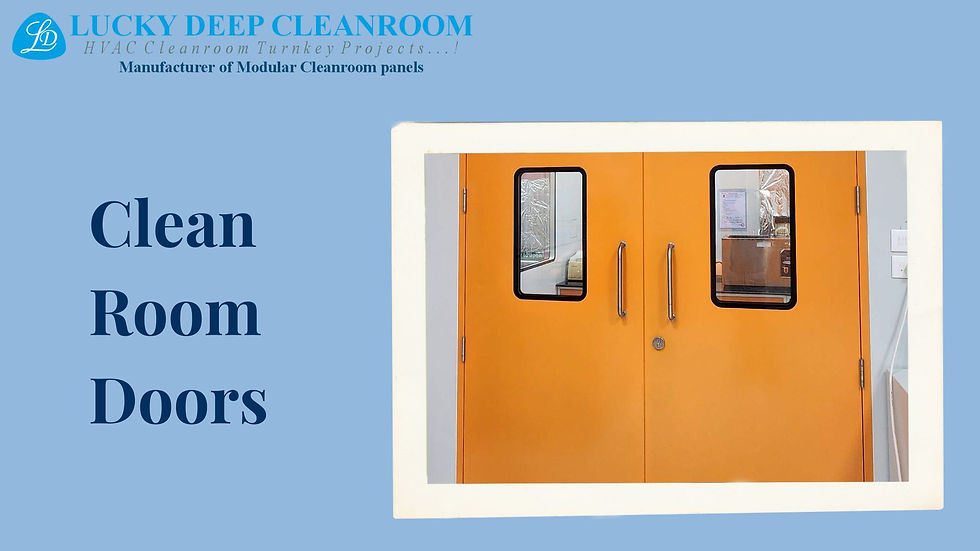Precision Engineered for Performance: Why Leading Clean Room Doors Manufacturers Prioritize Design and Durability
- Lucky Deep
- Jul 30
- 3 min read

In industries where hygiene, air quality, and controlled environments are non-negotiable—like pharmaceuticals, biotechnology, healthcare, and microelectronics—the humble door plays a critical role. Clean room doors are not merely entry and exit points; they are key components in maintaining environmental integrity. That’s why leading clean room doors manufacturers are committed to building doors that are durable, airtight, hygienic, and compliant with rigorous standards.
Engineered with Advanced Construction
Clean room doors are typically designed using double-skin construction, which offers strength and stability while maintaining lightweight features essential for easy operation. The construction of the door mimics that of modular cleanroom panels, ensuring seamless integration and aesthetic consistency across the controlled environment.
The materials used are vital to their performance. Top manufacturers use Galvanized Plain Sheet Panels (GPSP) with a thickness of 0.8 mm for the shutter and 1.2 mm for the frame. In applications that require fire safety, fire-rated clean room doors are constructed using thicker GPSP sheets—1.2 mm for the shutter and 1.6 mm for the frame—to provide enhanced protection without compromising on hygiene or design.
Shutter and Finish Options
The door shutter is available in thicknesses of 42 mm, 44 mm, and 46 mm, tailored to suit different cleanroom classifications and operational needs. Manufacturers often finish the doors with powder coating—applied in 60-80 microns thickness—to ensure corrosion resistance, chemical resistance, and a smooth, hygienic surface. For high-end environments or customer preference, stainless steel finishes are also available.
Size Versatility for Every Application
One of the hallmarks of professional clean room doors manufacturers is their flexibility in design. These doors come in a wide range of standard sizes, with frame thickness options of 50 mm, 80 mm, 100 mm, and 150 mm. Door widths can range from 750 mm to 2200 mm, accommodating everything from single-person entry to equipment movement.
This customizability ensures that cleanroom doors can be integrated into virtually any room layout or wall system—whether it's a pharmaceutical suite, a surgical room, or a semiconductor facility.
Accessories that Enhance Functionality
A door is only as efficient as its hardware. That’s why top-tier clean room door manufacturers equip their doors with premium-grade accessories, designed for safety, hygiene, and usability. These include:
Stainless Steel Hinges (3–4 per door)
D-type Handles made of stainless steel (300 mm length, 20 mm dia.)
Push Plates (125 x 300 mm stainless steel)
Dorma TS-68 Door Closers for smooth, controlled operation
Automatic Door Bottom Seals to prevent particle ingress
View Panels with 6 mm thick safety glass
Panic Bars for emergency egress
Flush Tower Bolts in double door configurations
Kick Plates (300 mm height in stainless steel)
Door Interlocking Provisions for cleanroom-grade airlocks
These features not only support hygiene and safety but also ensure that the door meets stringent cleanroom protocols.
Core Materials for Maximum Insulation
The internal filler material of a clean room door is a critical determinant of its thermal and acoustic insulation properties. Options include:
PUF (Polyurethane Foam) – 40±2 kg/m³
PIR (Polyisocyanurate Foam) – 48±2 kg/m³
ROCKWOOL – 96±2 kg/m³
Each material offers distinct advantages in terms of insulation, fire resistance, and sound dampening, allowing users to choose the best fit for their application.
The Manufacturer’s Edge
What sets leading clean room doors manufacturers apart is not just product quality, but their ability to deliver customized, certified, and installation-ready solutions. They understand that cleanroom infrastructure needs to support operations, ensure compliance with global standards (such as GMP, FDA, ISO), and stand up to years of daily usage without degradation.
Partnering with a reputed manufacturer also means access to full-cycle support—from design and planning to fabrication, installation, and post-installation service.
Conclusion
Clean Room Doors are silent guardians of contamination control. When specified and manufactured correctly, they serve as robust barriers against microbial intrusion, air turbulence, and pressure variation—all while facilitating smooth workflow and safety. For any facility seeking to uphold the highest standards of cleanliness and operational efficiency, investing in expertly manufactured clean room doors is not a luxury, but a necessity.




Comments